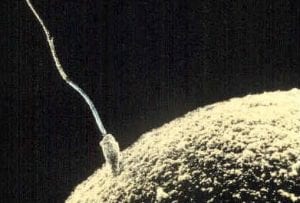
During fertilization, the sperm penetrates the egg. While both the sperm and the egg contribute to the offspring’s nuclear DNA, the egg alone provides the mitochondrial DNA. Source: http://commons.wikimedia.org/wiki/File:Sperm-egg.jpg
Imagine having three biological parents – three people’s DNA in a genome instead of just two. Developmental biology researchers and the U.S. Food and Drug administration are currently considering a way to achieve this for the purpose of preventing the transfer of defective mitochondrial DNA from mother to child (1).
People most often associate genetic diseases with mutated nuclear DNA, but many genetic disorders can also be caused by faulty mitochondrial DNA, which is transferred through the egg and therefore only inherited from the mother.
When an egg is fertilized, its nuclear DNA combines with that from the sperm, but the small pieces of DNA in the mitochondria of the egg remain unaltered. If this mitochondrial DNA is mutated, the resulting offspring could have a whole host of disorders, ranging from cardiomyopathy to dementia to optic atrophy (2). According to the United Mitochondrial Disease Foundation, the cells that are damaged the most are in the heart, brain, skeletal muscles, liver, and the respiratory and endocrine systems (3). In the U.S. alone, up to 4000 newborns are affected by these disorders every year (1).
Shoukhrat Mitalipov, a developmental biologist at Oregon Health and Science University, is working on creating human embryos by taking the nuclear DNA from the egg of a woman with defective mitochondria and placing it in an egg donated by an individual with healthy mitochondrial DNA (1). This egg would then be fertilized, and the embryo resulting from this procedure would in effect have three parents – two who provided each set of nuclear DNA, and one who provided the mitochondrial DNA.
A few years ago, Mitalipov conducted this experiment using rhesus monkey eggs to demonstrate the safety and efficacy of his technique. He implanted the eggs in uteri and allowing them to develop into healthy offspring. In humans, however, complications arose (4).
Results of Mitalipov’s experiments on human eggs showed that around half of the fertilized eggs presented with genetic abnormalities, and only 38% of the rest yielded apparently normal stem cell lines (1). The 50% of human eggs that were abnormally fertilized were left with an excess of maternal DNA, which rarely happened in the monkey models. In one case, a fetus was missing an entire X chromosome. According to Mitalipov, “it looks like human oocytes are more sensitive” (1).
Many additional concerns have been voiced by other researchers in the field of reproductive biology. For instance, incompatible mitochondrial and nuclear DNA have been shown in animals to lead to problems such as reduced growth, premature death, rapid ageing, and diminished reproductive ability (1). Another concern is epigenetics, which refers to any changes to the genome that do not result from direct changes to the sequence of nucleotides in genes. According to stem cell biologist Paul Knoepfler, the cytoplasm of the donor egg could alter the chemical tags of the nuclear DNA and consequently change the expression of the genes (1).
Ethical considerations must also be addressed. Possible dilemmas include deciding whether a child should have the right to know the identity of the egg donor, or if this procedure will eventually lead to the selection of certain embryos for specific, not medically-related traits (1).
Mitalipov acknowledges that it is imperative to proceed with caution in future research and clinical trials, but he remains optimistic about this fertilization method. He cites the now four-year-old rhesus monkeys produced by the mitochondrial transplants as evidence of the method’s safety. In addition, he counters Knoepfler’s concerns about chemical tag reprogramming by pointing out that the genetic material was transferred between cells with the same developmental state, diminishing the probability of reprogramming (1).
In January 2012, Mitalipov submitted an application to the U.S. Food and Drug Administration, which is currently in the process of examining his request. Mitalipov has stated that if he will not be allowed to perform clinical trials in the U.S., he might move his operations to the U.K. There, the Human Fertilisation and Embryology Authority (HFEA) has already concluded that human trials can be performed, on the condition that offspring are monitored long-term (1).
However Mitalipov eventually chooses to proceed with his research, people within developmental biology and beyond will watch his efforts carefully.
References
1. Hayden, Erika Check. “Regulators Weigh Benefits of ‘Three-Parent’ Fertilization.” Nature. 16 Oct. 2013. (Available at: http://www.nature.com/news/regulators-weigh-benefits-of-three-parent-fertilization-1.13959)
2. “Genetic Inheritance in Mitochondrial Disease: Fact vs Fiction.” MitoAction. 16 Oct. 2013. (Available at: http://www.mitoaction.org/blog/genetic-inheritance-mitochondrial-disease-fact-vs-fiction)
3. “What Is Mitochondrial Disease?” United Mitochondrial Disease Foundation. 16 Oct. 2013. (Available at: http://www.umdf.org/site/pp.aspx?c=8qKOJ0MvF7LUG&b=7934627)
4. Cyranoski, David. “DNA-Swap Technology Almost Ready for Fertility Clinic.” Nature. 16 Oct. 2013. (Available at: http://www.nature.com/news/dna-swap-technology-almost-ready-for-fertility-clinic-1.11651)
Leave a Reply